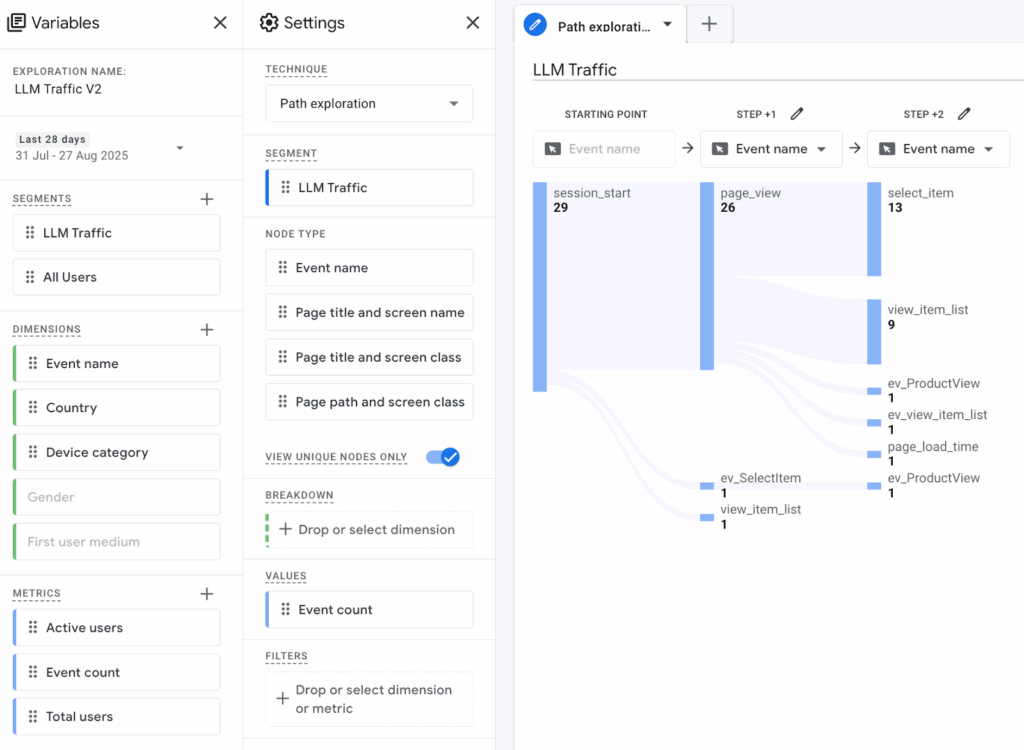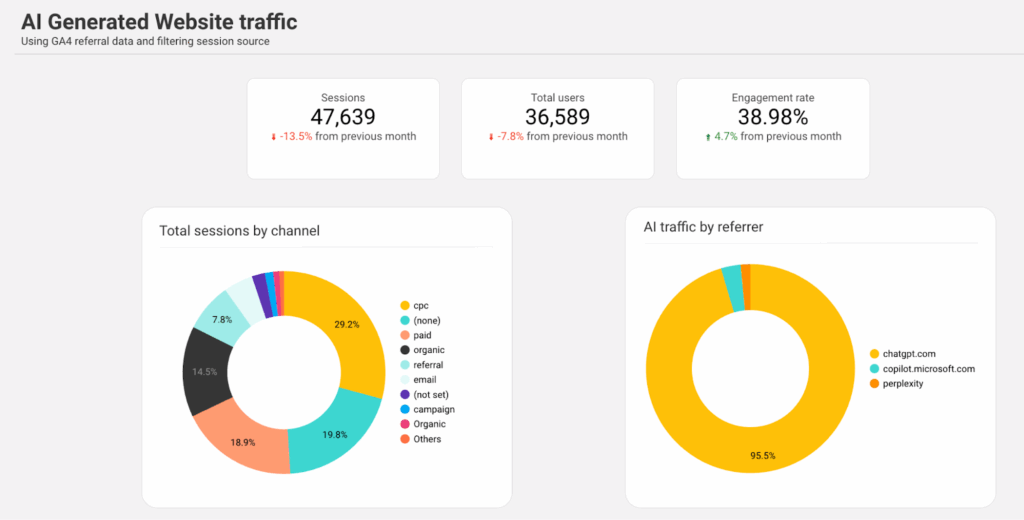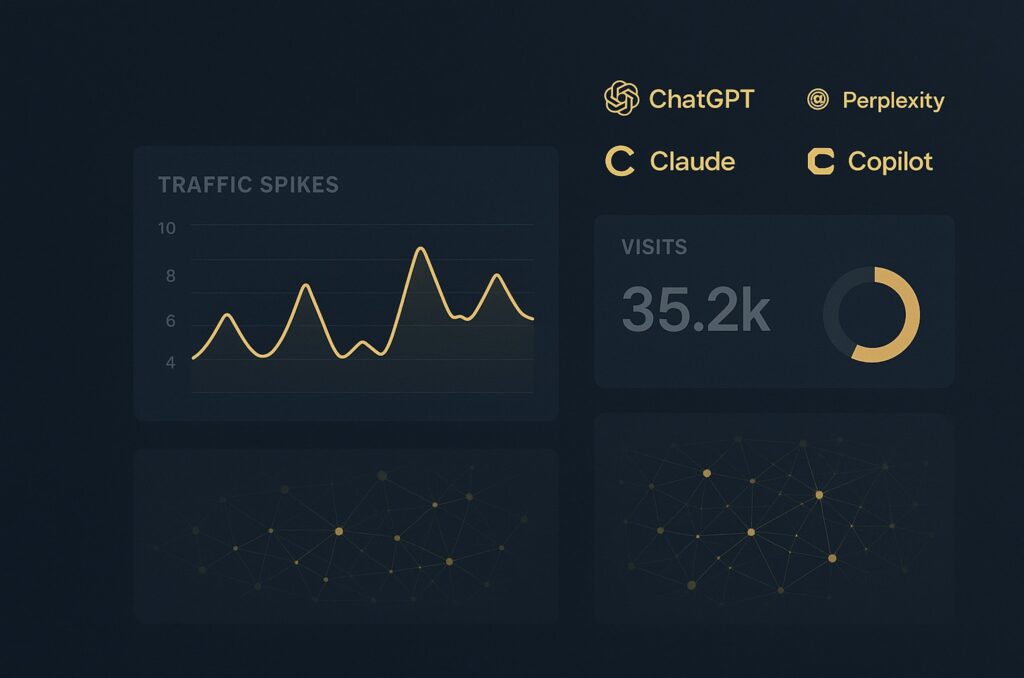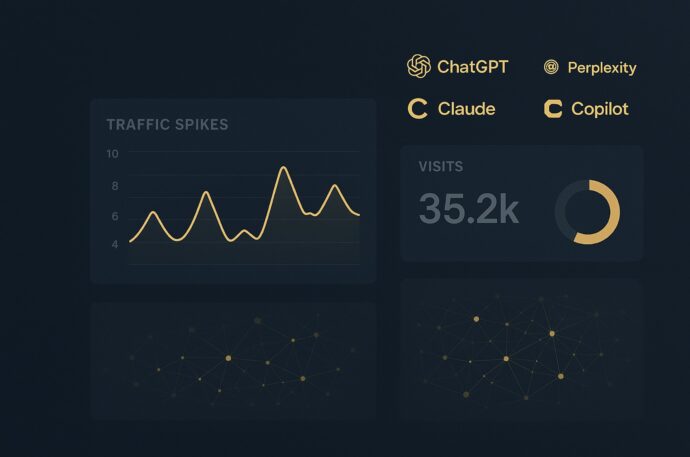Most SEO teams aren’t tracking traffic from large language models. That’s a problem. Not because the numbers aren’t huge yet, but because the way people search is changing, and most analytics setups aren’t built for it.
Tools like ChatGPT, Perplexity, Claude and Copilot are shifting how users discover content. Many people start with a question in an AI tool, rather than a search engine. These tools don’t just summarise answers. They link out. If that link points to your site, you’ll want to know.
If you’re not tracking it, you’re missing visibility signals. You’re also misreading performance, undervaluing high-intent content, and falling behind those who are watching closely.
Beyond clicks, it’s about making sure your brand and content are surfaced and represented the way you intend.
In short: LLM tools like ChatGPT and Perplexity are already sending traffic to your site – but most analytics don’t track it. If you’re not measuring it, you’re missing visibility signals and undervaluing high-intent content. The fix is simple: use GA4 to capture LLM referrals and set up custom dashboards for live reporting
LLM Traffic Is Surging, And Most Brands Aren’t Tracking It
LLM-driven traffic is small but growing fast. According to Similarweb, traffic from Perplexity and ChatGPT to websites has increased by more than 300% in the past year. OpenAI reports more than 5.72 billion visits to ChatGPT per month.

LLM traffic tends to be:
- High intent. People ask focused questions.
- Mid funnel. Users are often comparing, researching or clarifying.
- Poorly tracked. It shows up as ‘Direct’, ‘Referral’, or sometimes nothing at all.
If you’re not actively surfacing this traffic, you’re underreporting your organic reach and missing how your content is influencing decisions.
This shift is part of a broader move in search. We broke this down in a blog titled “Modern SEO Content that Works in 2025”, where we covered how AI tools are reshaping what “good” content means and why structure and clarity matter more than ever.
What Are You Actually Tracking?
Before diving into GA4 or custom dashboards, get clear on what matters.
More than being about vanity metrics, LLM answers a few key questions:
- Which pages are being picked up by LLMs?
- What kind of sessions are they driving?
- Are those visits converting or adding value?
- What should I prioritise because of it?
With those in mind, you’re not just watching trends. You’re building a strategy around them.
If this feels like it overlaps with zero-click search or assisted search behaviour, it does.

How to Track LLM Traffic with Tools You Already Have
1. Use GA4 Exploration Reports
Start in GA4 Explore. Set the ‘Session source/medium’ as the primary dimension. Filter for referrers like:
- chat.openai.com
- copilot.microsoft.com
- perplexity.ai
- gemini.google.com
- claude.ai
Then add ‘Landing page’ or ‘Page path’. You’ll start to see which pages are bringing in visitors that aren’t coming through Google or social.
Pages that surface here should be treated like high-performing organic assets. They’re delivering value, even if your SEO tool can’t see it.

2. Build a Custom Report in Looker Studio
Create a report that includes a segment for those known LLM referrers. Then track:
- Sessions
- Engagement
- Conversions
Compare this segment to your organic and paid traffic. If LLM-driven visits are more engaged or more likely to convert, that’s a sign you’re being surfaced in the right places.
Use this to inform content planning and prioritise optimisation for the pages that are getting picked up.


3. Use Brand Radar (Ahrefs) to Monitor Mentions
Brand Radar indicates when your content gets mentioned inside LLM responses.
Use it to:
- Spot when your brand or URLs are surfaced by AI tools
- Track which competitors are showing up where you’re not
- Identify content that gets cited often but doesn’t drive traffic
This won’t give you traffic numbers, but it shows influence. Pair it with GA4 to connect mentions with engagement.

Source: Brand Radar, ahrefs.
4. Set Alerts for Spikes in Direct Traffic
LLM visits often show up as direct sessions to in-depth content. Set alerts for unexpected spikes on URLs that don’t usually get that kind of activity.
When it happens, cross-reference with Brand Radar or recent social chatter. It might be a new mention from ChatGPT or Perplexity.
5. Use Semrush to Catch Referral Clues
You won’t see LLM-specific sources in Semrush, but you can still spot:
- New backlinks to older content
- Unusual referrers
- Sudden increases in branded traffic without a campaign behind it
This helps connect dots between LLM influence and traditional visibility signals.
6. Run Controlled Content Experiments
Pick a few topics, write clearly structured, answer-focused content, and include subtle tracking (like UTMs or shortened links). Then monitor:
- Page-level traffic in GA4
- Mentions in Brand Radar
- On-page behaviour
You don’t need to win every LLM mention. You just need to learn what works and build from there.
We go deeper on this in our blog that covers the future of search,, especially how discovery and conversion work when AI tools are the starting point.

What to Do With the Data
Once you have the right tracking in place, the next step is to use it.
- Update content that’s getting visibility but no action
- Build new content clusters around topics that AI tools pull from often
- Adjust reporting to include LLM traffic as its own source
- Use behavioural data to improve UX on pages with LLM interest
You’re not just watching traffic. You’re learning how users find, trust and act on your content in ways that don’t show up in keyword reports.
Don’t Miss What Your Content Is Already Achieving
LLMs are changing how discovery works. Some of your best content might already be getting traction you can’t see yet.
You don’t need perfect attribution. But you do need to know when your content is doing its job, even when traditional tracking methods miss it.
Start watching. Start testing. Start acting on it.If you need help setting up a proper tracking framework or turning the data into decisions, talk to us. We’re already doing it.



